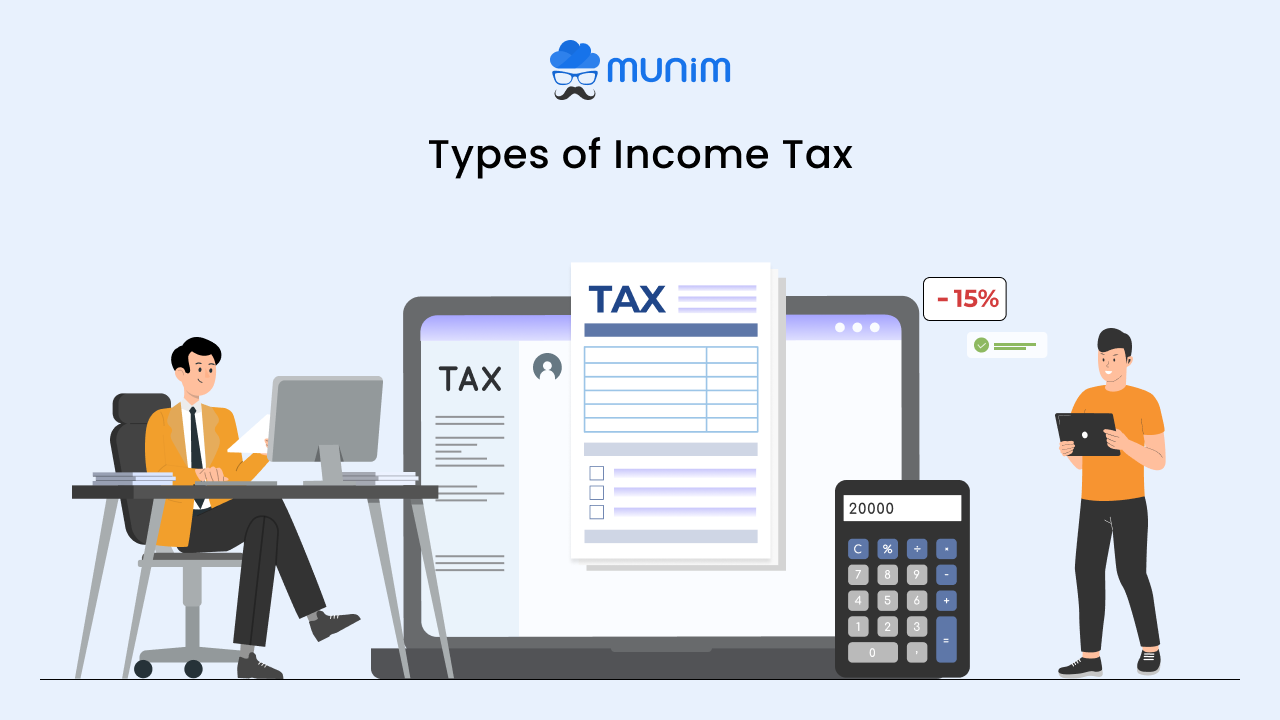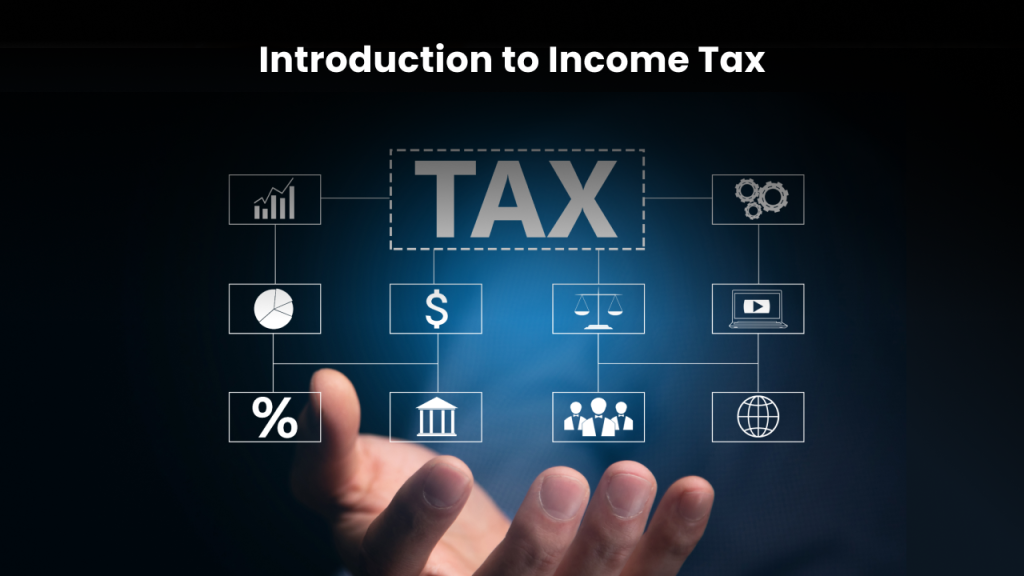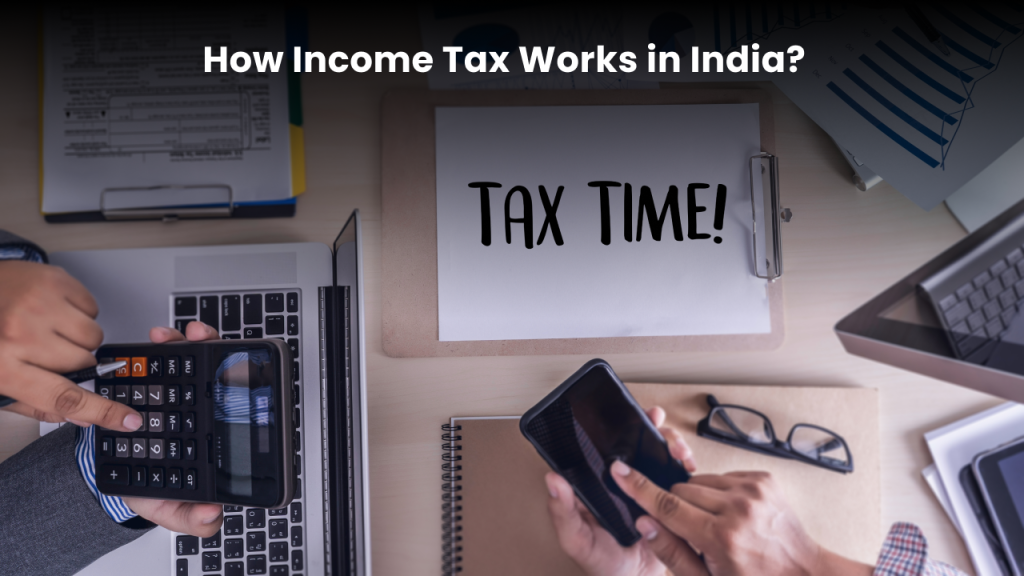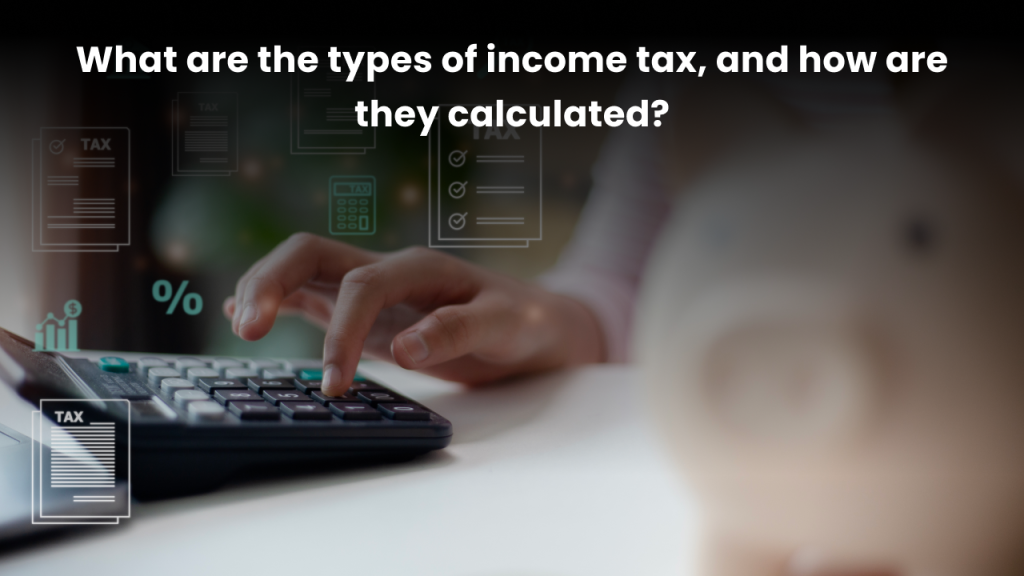What is Income Tax, and how are Different Types Calculated?

Taxation laws have prevailed in India to boost our economy. Income tax regulations ensure revenue generation for the nation’s development.
Let’s scroll down to the blog in detail.
Introduction to Income Tax

The tax imposed by the government on business or individual income is known as income tax. According to the law, taxpayers should annually file tax returns to identify their tax obligations. These taxes are considered to be a source of revenue for the government.
The revenue generated through the taxes paid by individuals or businesses is used for public welfare.
Individual income tax is levied on a person’s salary, wages, and other income.
Business income tax is a duty on income generated by malls, businesses, partnerships, and freelancers.
How Income Tax Works in India?

In India, the application of income tax laws depends upon the residential status of taxpayers. Indian residents must pay duty on their global income earned in India and abroad. For non-residents of India, taxes are applied to their income generated in India.
For every fiscal year, the residential status is determined separately, for which taxes and income are calculated.
What are the types of income tax, and how are they calculated?

- Individual Income Tax
- Individual or personal tax is levied on a person’s salary, wages, and other income sources.
- The state government generally imposes this tax due to exemptions, deductions, and credits.
- Most of the individuals skip paying taxes on their entire income source.
Here’s how individuals calculate their tax in India
- List income sources such as salary, house property, business profession, stocks, capital gains, and others.
- Calculate the sum of all the income i,e. Gross Total Income (GTI)
- Now, subtract exempt income from the total revenue. These incomes include agricultural income, house rent allowance, employee travel concession, and more.
- Once you receive the total income post exemptions, deduct eligible amounts. They cater to investments in PPF or other schemes, donations to charitable trusts, etc.
- The amount after deductions is the net taxable amount applied according to the applicable income tax slabs.
- Tax the income based on the slabs given below:
| Income Tax Slabs | Tax Rates |
| < ₹300,000 | NIL |
| ₹300,000 to ₹500,000 | 5% |
| ₹500,000 to ₹10,00,000 | 10% |
| >₹10,00,000 | 30% |
- Now, you need to apply for the rebates and credits, if any.
- Compute the final tax liability after considering all exemptions, deductions, and credits.
- Consider the tax paid in advance and TDS deducted from the salary.
- Fill out the ITR form to file the income tax returns.
- Business Income Index
- Income tax is applied to all small and big-sized businesses.
- The taxes are applied to corporations, big giants, self-employed or freelancers, small businesses, and more.
- The income tax calculations depend on the business structure, operating process, and capital expenses.
Here’s how income tax is calculated for businesses:
- Collect all receipts for business turnover during the financial year. These receipts cater to sales invoices, service income, etc.
- Calculate gross profit by deducting the allowable business expenses. These expenses include property rent, salaries, utilities, depreciation, and other business expenses.
- Tax will be applied to this income once you arrive at the net profit.
- Determine the total taxable income by adding other sources of revenue.
- Calculate the tax for the amount based on the tax laws.
Types of Business Income Tax
- Corporate Tax
- Corporate tax is applied to the income of companies legally registered in India.
- The corporate tax rate is 22% for existing domestic companies in India.
- A 15% tax rate is applied for new manufacturing companies.
- Minimum Alternate Tax (MAT)
- MAT is applicable to companies with low or no profit due to exemptions and deductions.
- These companies share good profits but don’t pay taxes or pay them at a rate lower than the MAT.
- Capital Gain Taxes
- Capital gain taxes are applied to profits derived by selling an asset.
- Assets like stocks, shares, property, MFs, cryptos, NFTs, etc, lie under this category.
- There are two types of capital gain taxes:
- The Short Term Capital Gains
STCG is the gain derived from the sale of assets locked for up to 36 months. These assets include MFs, real estate, and shares.
- The Long Term Capital Gains
Assets locked for more than 36 months are considered LTCG or long-term capital gains.
Here’s how capital gain taxes are calculated:
- Tax for STCG is based on the applicable income tax slab rates for the assets.
- LTCG is the difference between the sale price and the indexed cost of acquisition.
- The cost inflation index (CII) is used to adjust the indexed cost for inflation.
- The taxpayer can claim an exemption for capital gains arising from a residential property by investing in another inhabited area.
- Report the capital gains in the income tax return and file ITR before the due date.
- To avoid complexities, you can leverage a capital gain tax calculator.
Are you finding the process tedious? Munim has a perfect solution for you!
Munim offers tax recording, computations, and filing in a single go with its GST solution. Our GST filing solution automates all your tax filing procedures, ensuring transparency.
Here are a few perks that make our GST solution stand out in the market:
- Our GST return Filing software offers accuracy in every tax computation to avoid errors.
- It is easy to use and does not require any technical training.
- It automates tax calculations, recording, and filing.
- The dashboard clearly explains taxes filed, pending, and overpaid tax returns.
Wrap UP
Hopefully, the blog was helpful to you! Stay tuned with us for more informative blogs. If you have queries, shoot them here; we will surely answer them.
FAQs
- What percentage of income is taxed?
The taxed income percentage depends on your annual income and filing status. For income below 3LPA, no tax is applied, for income between 3LPA and 5LPA, 5% tax is charged, for 5LPA to 10LPA, 10% tax is applied, and for income above 10LPA, 30% is levied.
- Can I use Munim for ITR filing?
Yes, Munim can assist you in ITR filing, especially for businesses and other ventures.
- Can Munim offer 24X7 customer support?
The experts of Munim are available round the clock to resolve all your queries.






